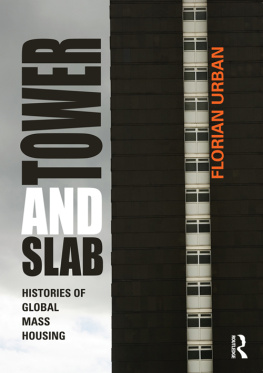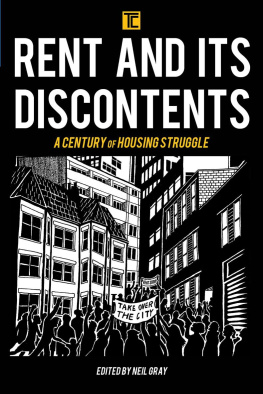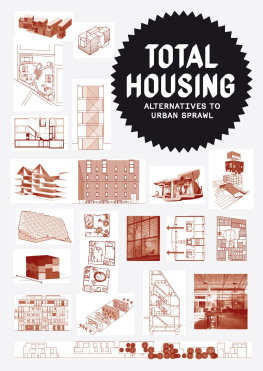Tower and Slab
Tower and Slab looks at the contradictory history of the modernist mass housing block home to millions of city dwellers around the world. Few urban forms have roused as much controversy. While in the United States decades-long criticism brought about the demolition of most mass housing projects for the poor, in the booming metropolises of Shanghai and Mumbai remarkably similar developments are being built for the wealthy middle class. While on the surface the modernist apartment block appears universal, it is in fact as diverse in its significance and connotations as its many different cultural contexts.
Florian Urban studies the history of mass housing in seven narratives: Chicago, Paris, Berlin, Braslia, Mumbai, Moscow, and Shanghai. Investigating the complex interactions between city planning and social history, Tower and Slab shows how the modernist vision to house the masses in serial blocks succeeded in certain contexts and failed in others. Success and failure, in this respect, refers not only to the original goalsto solve housing crises and provide modern standards for whole societiesbut equally to the changing significance of housing blocks within the respective societies and their perception by architects, politicians, and inhabitants.
These differences show that design is not to blame for mass housings mixed record of success. The comparison of apparently similar projects suggests that triumph or disaster does not depend on a single variable but rather on a complex formula that includes not only form, but also social composition, location within a city, effective maintenance, and a variety of cultural, social, and political factors.
Florian Urban is Head of Architectural History and Urban Studies at the Mackintosh School of Architecture, Glasgow School of Art. From 2006 to 2008 he taught at the Center for Metropolitan Studies, Technische Universitt Berlin. He holds a Master of Fine Arts from the Hochschule der Knste Berlin, an MA in Urban Planning from UCLA, and a PhD in History and Theory of Architecture from MIT. He is the author of Neo-historical East Berlin Architecture and Urban Design in the German Democratic Republic 19701990 (Ashgate, 2009).
Tower and Slab
Histories of global mass housing
Florian Urban

First published 2012
by Routledge
2 Park Square, Milton Park, Abingdon, Oxon OX14 4RN
Simultaneously published in the USA and Canada
by Routledge
711 Third Avenue, New York, NY 10017
Routledge is an imprint of the Taylor & Francis Group, an informa business
2012 Florian Urban
The right of Florian Urban to be identified as author of this work has been asserted by him in accordance with sections 77 and 78 of the Copyright, Designs and Patents Act 1988.
All rights reserved. No part of this book may be reprinted or reproduced or utilised in any form or by any electronic, mechanical, or other means, now known or hereafter invented, including photocopying and recording, or in any information storage or retrieval system, without permission in writing from the publishers.
Every effort has been made to contact and acknowledge copyright owners. If any material has been included without permission, the publishers offer their apologies. The publishers would be pleased to have any errors or omissions brought to their attention so that corrections may be published at a later printing.
Trademark notice: Product or corporate names may be trademarks or registered trademarks, and are used only for identification and explanation without intent to infringe.
British Library Cataloguing in Publication Data
A catalogue record for this book is available from the British Library
Library of Congress Cataloging in Publication Data
Urban, Florian.
Tower and slab : histories of global mass housing / Florian Urban.
p. cm.
Includes bibliographical references and index.
1. High-rise apartment buildingsSocial aspects. 2. Housing. 3. Architecture and society. I. Title. II. Title: Histories of global mass housing.
HD7287.6.A3U73 2011
363.5dc22 2011010078
ISBN: 9780415676281 (hbk)
ISBN: 9780415676298 (pbk)
ISBN: 9780203804131 (ebk)
Acknowledgements
My first words of gratitude go to the inhabitants, architects, planners, and scholars from seven different metropolises who took their time to share with me their experiences and opinions, and thus allowed me a glimpse into the diverse built environments that mass housing constitutes in these places. Their help was invaluable.
This book started in 2003 as a sideline project during my doctoral studies at MITs History, Theory, and Criticism of Architecture program. Although the passages had long been discarded, the ideas connected with them lingered on. I would therefore like to thank my doctoral advisors Mark Jarzombek and Larry Vale for their guidance and support.
At the Center for Metropolitan Studies, Berlin Technical University, where I taught from 2005 to 2008 and where this project eventually came to fruition, I was surrounded by a collegial and supportive atmosphere that significantly contributed to the advancement of my work. Thanks to my colleagues Heinz Reif, Katja Sussner, Dagmar Thorau, Dorothee Brantz, Susanne Stemmler, and Oliver Schmidt. A generous grant from the Fritz-Thyssen Foundation funded the travels and research necessary for this book.
At the Mackintosh School of Architecture, Glasgow School of Art, I was able to work in an office with a direct view onto the built results of one of Europes most ambitious mass housing programs, and encountered an inspiring environment to finalize some of my ideas. My warmest thanks to my students and colleagues.
I would also like to acknowledge the input and advice of various individuals who work on similar topics and helped me to clarify my thoughts.Thanks in particular to Richard Williams, Herv Vieillard-Baron, Sofia Shwayri, Frank Wassenberg, Miles Glendinning, Richard Dennis, Rosemary Wakeman, Nikhil Rao, and Jean-Louis Cohen.
In particular I am grateful for the indispensable help of my graduate students who provided me with information, translations, photos, and insightful comments. My warmest thanks to Angelikawiderska, Ang Ye, Carsten Schmidt, Laurent Jachetta, and Di Wang.
Many friends and colleagues contributed to the growth of this work with astute comments, helpful feedback, and moral support; they helped to shape my thoughts, improve my style of writing, and clarify many doubts about the places they often knew so much better than I. Thanks to Michael Osman, Lize Mogel, Caroline Labusch, Silke Morgenroth, Kirsten Kofahl, Aleksandra Roth-Belkova, Gerald Roth, Kirsten Weiss, Cai Lin, Ying Zhou, Guzel Sabirova, Alla Vronskaya, Natalya Belkova, Priyanka Basu, Martin Schwegmann, Steve Rowell, Khadija Carroll, Alex Schweder, and Augusto Areal. Last but not least, I cannot thank my father and Marcela enough for their love and endless support.
Preface
by Mark Jarzombek
This book touches on a core problematic lurking within the concept of the modern city: housing. It is a rather innocuous word that emerged in the late nineteenth century in England, especially following the so-called Housing of the Working Classes Act of 1890. The word appeared subsequently in dozens of titles typically entitled The Housing Problem in London (1899), The Housing of the Poor (1891), or Housing of the Working Classes in Rural Districts (1891). By the middle of the twentieth century, housing was not just a problem, but in some places an investment opportunity, in other places an instrument of state-sponsored social control, and elsewhere even the core element of the lifestyles of the wealthy and middle classes. This leads to a question about the framing urban history. How does a city register its image unto itself when it comes to one of its obvious functional requirements, namely housing? In that sense, housing is still a problem, but of a different type than a hundred years ago.
Next page










